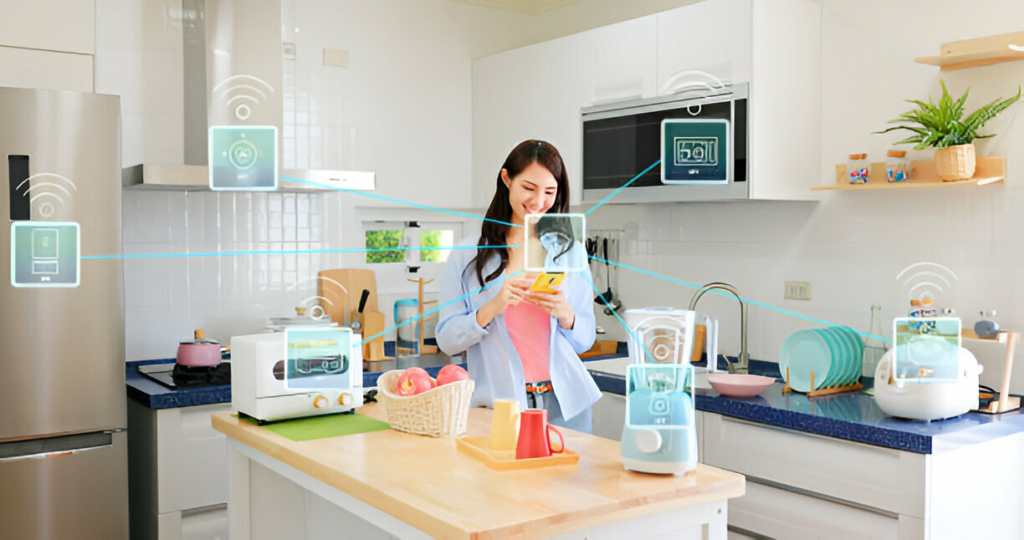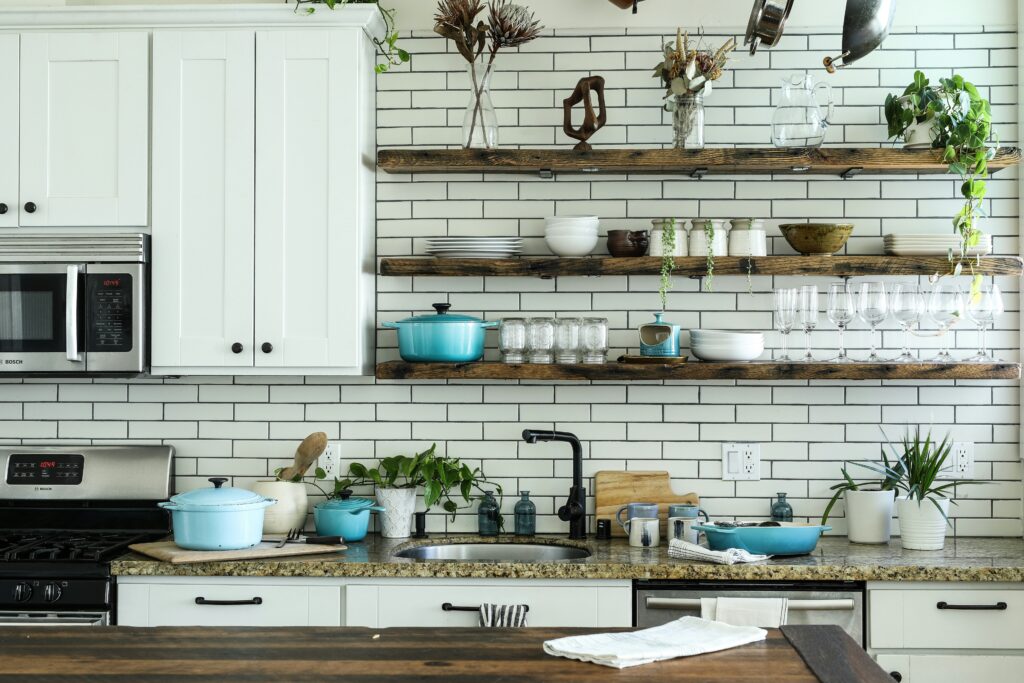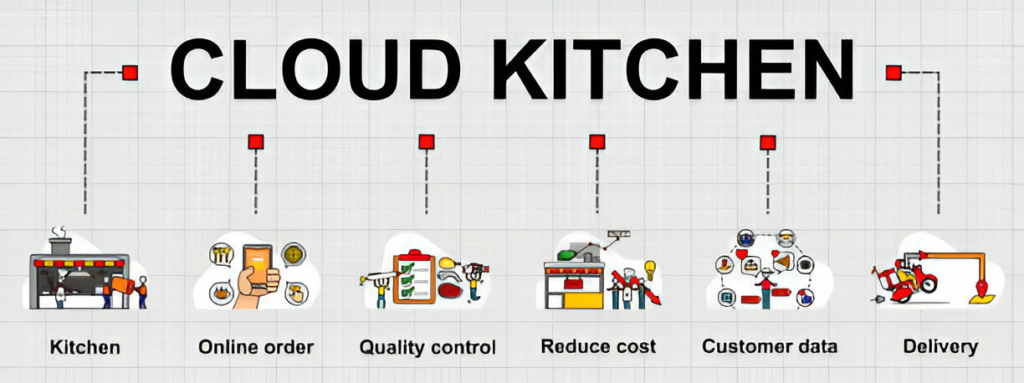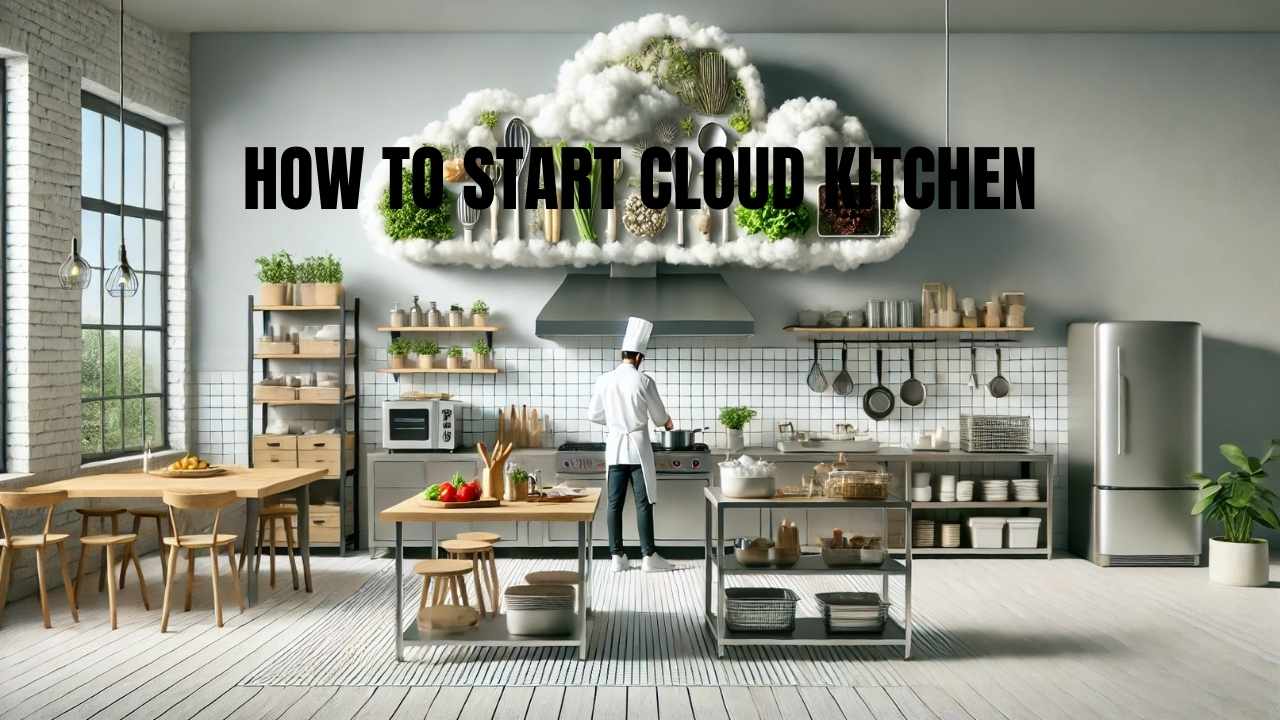A cloud kitchen, in 2025, is a tremendous opportunity for entrepreneurs to penetrate the booming food delivery market. It is often called a ghost kitchen or virtual kitchen, which refers to a delivery-only food establishment that operates without a physical dine-in space.
This innovative business model eliminates high overhead costs associated with traditional restaurants – prime real estate and interior decoration – and will focus solely on food preparation and delivery through an online ordering portal. As of late, given the proliferation of food delivery applications and the push for convenience by consumers, setting up a cloud kitchen has also become a popular choice by new food establishments.
Whether you are an experienced restaurateur or a first-time entrepreneur, opening a cloud kitchen has many advantages regarding scalability, cost-effectiveness, and market coverage. In this article, we will guide you step by step on how to start a cloud kitchen in 2025, from concept to execution, ensuring you are prepared to succeed in this fast-growing industry.
Cloud Kitchens: Revolutionizing the Food Industry
Popular today as cloud kitchens, ghost or dark kitchens are about to change the food industry dramatically and expand the possibilities of restaurant business based on delivery services. These are efficient retail kitchens designed to cook meals, but they lack a counter space to operate from and strictly use delivery mode to access clients.
1. Cost Efficiency:
Cloud kitchens cost less to operate because they’re less dependent on prime locations, human faces, and dining areas. This cuts down operational costs so much thereby giving clients an opportunity for affordable prices.
2. Flexibility and Scalability:
These kitchens can easily expand operations by introducing many brands or options within the same kitchen. This means that with the help of forums, an entrepreneur can try out a new idea and spread the idea to other individuals with slight risk involved.
3. Focus on Delivery:
Cloud kitchens are created with food delivery applications in mind as they are tailored to constantly provide hot food quickly and with good packaging. This fits well with the current trend of looking for the speed at which foods can be consumed.
4. Technology Integration:
Cloud kitchens use technology in ordering, and managing customers and the kitchen. Order tracking in real time, supply chain management and a myriad of other applications enhance business operations and customer satisfaction.
5. Targeting Niche Markets:
Cloud kitchens offered a great opportunity for entrepreneurs to target specific or localized segments due to the limitations of an actual restaurant. This has resulted in widespread hyper-localization of food delivery and niche occidental cuisines that may not survive in an M-to-M physical store format.
6. Adapting to Consumer Trends:
With cloud kitchens, it is easy to test new dishes, modify an existing offering depending on the reception it gets, or provide its workers, and consequently clients. These experiments are very important in the dynamic environment prevalent in the food industry.
7. Lower Entry Barriers for Entrepreneurs:
Owning a food business is now much easier because the establishment of cloud kitchens can be done with a comparatively low cost and facilities than the brick and mortar restaurants. This creates some entries for new-generation chefs and food business enthusiasts to venture into the market with less risk.
In general, cloud kitchens are striving on how foods are prepared, advertised and delivered, and are well suited to successfully grasp modern-day challenges to fulfill the growing needs of the food industry.
Difference Between Cloud Kitchens and Traditional Restaurants?
| Criterion | Cloud Kitchens | Traditional Restaurants |
|---|---|---|
| Business Model | Dine with no physical establishment in which the guests can be hosted. Most of them are mainly concerned with food preparation for delivery through online orders. | The plan should incorporate an area for eating such as a dining area where customers can eat their food in a particular restaurant. This area will mostly contain more appeal and services. |
| Operational Costs | Have lower overhead costs because they don’t have to take a location in the central business district, repaint the inside of the establishment, or hire waiters and waitresses. | Usually, they have higher operating costs because they need to secure premises, acquire furniture and hire employees to deal with customers. |
| Market Reach | Can reach out to more consumers compared to restaurants that strictly rely on the sale of take out food by perhaps having to use other delivery applications and online ordering platforms that are within the reach of those clients. | Largely depend on the people traffic and positioning to market their products thus are only able to target a nearby area. |
| Flexibility | Can have multiple brands or virtual restaurant concepts all under one roof, which increases the variety of offerings and easy to change them. | Most often are single units trading under a single name and featuring a limited and standardized set of items on a menu. |
| Technology Integration | Closely connected to the role of technology for futuristic orders and delivery and maintaining a strong customer interface throughout technology channels. | Although reservation and POS systems are integrated the role of technology is not as dominating as in the cloud kitchens case. |
How to Start Cloud Kitchen! (Step By Step Guide)
The cloud kitchen industry’s high profit margins attract many players, making it the first choice for small business ideas. The ecosystem is maintained by the internet and smartphone penetration and the growth of online food collectors. So, without further ado, let’s dive in!
Step 1. Know your customers

Demographics play a significant role in the achievement of a cloud kitchen. Before you start a business cloud kitchen, you must know your customers and to whom you want to serve. For example, the requirements of a family are wholly different from those of a young, gym-going twenty-something. Families require a well-adjusted meal, while gym-goers prefer protein-rich food. So, you should know your business before you develop your food concept, menu offerings, and marketing tactics.
Step 2. Choose a concept

How do you choose the correct notion for your cloud kitchen? The first step is to find out what your customers are looking for. One way to do it is to go online and then google. For example, if you are targeting health-conscious people, you must find out what food they prefer. To find out about the preferred cuisine of your target audience, you can go to diverse forums like Facebook. You can check the dietary preferences of diverse groups there.
Step 3. Gain Experience
Running a cloud kitchen strains knowledge in a wide variety of fields. Apart from the rudimentary cooking knowledge, knowing about accounting, marketing, and finding raw materials will be good. A degree in hotel management, besides some work experience in the hospitality sector, will aid you immensely.
Step 4. Study your competition
See which famous dishes your intrants are serving and what they are not. Also, which items are in high demand and are selling well? For example, if you see that gluten-free doughnuts are life-picked up by many customers, you know it is a gifted product.
Step 5. Costs
Increasing a restaurant is easier than you think. With commercial kitchens optimized for delivery, you can launch a new-fangled location in less than a month. The cost is 40 to 50% less than a brick-and-mortar cafeteria. The real estate costs and labour incidentals will be far less.
You can bear the initial start-up costs as of your savings. If you don’t have sufficient funds, you can ask your household or friends for help. Another option is to pay your local bank for a business loan.
Step 6. Location

You need not trace your cloud kitchen in a prominent location. An industrial zone or a back alley in a neighborhood will work just fine. A low fee will translate into a lower brokerage and CAPEX cost. 500 square feet planetary will suit your requirements just fine. Make sure to have a driver parking area with a seamless delivery system.
Step 7. Get a license
You must get an FSSAI license to order how your food is stored, cooked, and brought. The license period is valid from one to five years and must be transformed periodically. You can mention the FSSAI number on your packing to inspire customer confidence.
Step 8. Equipment
Most of your initial reserves will be spent on equipping your cloud kitchen. The list includes countless ovens, burners, utensils, plumbing, etc. One option is to rent an operational cloud kitchen tailored with essential equipment to customize it per your requirements.
Step 9. Quality of food
You have to keep the excellence of your food very high, or else it will eat into your status. Hire a good chef who is an expert in your chosen cuisine. Use fresh ingredients and try to foundation them locally.
Step 10. Packaging
The only point of contact between you and your customers is the wrapping. You can develop your brand through imaginative packaging. You can pack the meals in biodegradable wrapping instead of plastic to reduce your carbon footprint. The food should be sealed correctly to avoid contamination.
Step 11. Pandemic Precautions
While safety and hygiene have always been vital in the food industry, you should now take an extra position in this if you want your business to thrive. You must check the temperature daily for all kitchen and transfer staff. The staff should wash their hands regularly and sanitize the kitchen frequently.
Step 12. Technology

You can track your instructions without a hitch using technology. When a customer chairs an order through an app, you can view that on your mobile, laptop, or tablet. You can rent a chef to do the cooking or do it yourself with some help.
Step 13. Delivery
You have to hire a decent driver. Delivering food accurately and promptly means a lot of happy customers. You can also use online food transfer platforms like Swiggy and Zomato to facilitate logistics. Launching your food trucks with popular substances like chicken pizza or biryani is an added option.
Marketing Strategies for Cloud Kitchens: Building a Brand Without a Physical Presence
The marketing strategies followed for cloud kitchens revolve around the concept of marketing food and creating a store image through the use of an online platform and constant contact from the consumers. Key strategies include:
- Digital Presence: Be constantly visible on social media, food delivery apps and platforms, Google etc.
- SEO and Online Reviews: Namely, SEO makes the site easily searchable on the web; moreover, using customers’ feedback is more trustful for them.
- Targeted Advertising: To the right set of audiences, this means that more mobile ads should reach the desired audience through demographic targeting, geographic targeting, and food apps.
- Customer Engagement: Create loyalty programs and then use coupons to give customized offers through an email or mobile application.
- Influencer Marketing: Use food influencer marketing to get more people to know your brand and become loyal customers. They assist cloud kitchens in building the brand and trust such that technology and the use of online services tend to sell the foods.
Investment Opportunities in Cloud Kitchens
Cloud kitchens have become the more attractive forms of investment due to their operational efficiencies and low unit economics. Some of the key investment areas are as follows:
1. Franchise Models:
Franchising in cloud kitchen businesses gives the entrepreneurship opportunity to buy a brand and business formula without having to grow it from the bottom.
Because of its low risk, franchising is a popular model where many cloud kitchen brands can expand fast.
2. Technology and Platforms:
Technology and primarily related to the facilitation of the provision of food delivery and orders, with advancements in food delivery platforms, ordering solutions online and supply chain, opportunities to develop process streams to provide value services to the customers.
3. Infrastructure and Real Estate :
But cloud kitchens do not necessarily require great locations so there is still demand for good locations. There are new buildings that investors can buy or rent for cloud kitchens containing facilities meant for commercial use.
4. Food Brands and Virtual Kitchens:
Returns can be offered by the cloud kitchens without physical restaurants thus making this a profitable option; one could go about creating new menus or even regional food offerings through partnerships or even venturing solo by launching new virtual food brands.
5. Logistics and Delivery Solutions:
A huge concern for the cloud kitchens has been on deliverability. Therefore, investing in efficient logistics companies or last-mile delivery providers becomes an excellent opportunity for better control over the huge of the customer base.
Now these investment opportunities available from cloud kitchens provide much more Returns on Investment due to Lower Capital Intensity, Flexibility and Relevance in Online food Delivery Services.
Conclusion

Therefore, investing in a cloud kitchen in 2025 presents the exciting opportunity of cashing into the rapidly burgeoning phenomenon of online food ordering at relatively low levels of investment and costs of operations. With technologically aided operations comprising online ordering websites, data analytics, and the streamlined delivery model, entrepreneurs could foster their business ventures in the operation that would be highly streamlined, based on customer satisfaction and profitability. This includes market research, location selection, an efficient kitchen design, and collaboration with food delivery applications to acquire higher customer reach.
Strong marketing strategies with quality food will ensure customer loyalty and brand growth. With the trend of virtual dining supported by the continuously increasing number of online food orders, the brand outlook for cloud kitchens has lately become incredibly promising. Cloud kitchens are likely to take over the food service industry if they adapt to the current trends and innovate in a way that ensures resilience in the emerging food industry landscape.
FAQs
1. What is a Cloud Kitchen?
A cloud kitchen is otherwise known as a ghost kitchen or virtual kitchen, which operates purely as delivery-only food, having no sit-down storefront available to customers for dine-in options. It will specialize in providing prepared food ordered online or via platforms like apps for food deliveries.
2. What are the advantages of a Cloud Kitchen?
The advantages include low operational cost, upscale location or interior needs, large scalability, flexible menu offerings, and the potential to serve a significantly larger customer base through food delivery apps. There is also scope to try out a variety of cuisines and concepts.
3. How do Cloud Kitchens make money?
A Cloud Kitchen makes its revenues through the preparation and delivery of food ordered on platforms such as Zomato, and Swiggy, or through their websites. Revenues primarily work on the principle of the number of orders as there is no dine-in, thereby saving costs and increasing margins.
4. What does it take to start a Cloud Kitchen?
First, you would need a commercial kitchen space, licenses and permits, a good supply chain, an online ordering system, a marketing plan, and good kitchen staff. A good digital presence is important as well.
5. Can I run multiple brands from a single Cloud Kitchen?
But yes, the cloud kitchen has benefits; you can operate various virtual brands from one single kitchen space. That also helps you to provide diverse menus and cuisines or even experiment with different tastes and flavors to make good use of the kitchen, the space as well as utilities.
6. What are the challenges faced by the Cloud Kitchens?
Huge competition, delivery logistics management, quality of food after delivery, brand recognition since no place of work is visible, and the service needs to be constantly constant and function effectively over operational costs.
7. How do Cloud Kitchens manage their deliveries?
Most of the cloud kitchens have a tie-up with third-party delivery platforms like Swiggy, Zomato, or Uber Eats for logistics to deliver food. In some cases, they even manage the deliveries through their fleet. Proper delivery management will help to provide timely delivery and satisfaction to a customer.
8. Is running a Cloud Kitchen Profitable?
Yes, well-managed ones can be quite profitable. Read more about this below. Low operational costs; a lot more customers can be served; thus, more profit. But all these are location-dependent, marketing plans, order quantity, and quality of food.
9. Do I need a physical restaurant to start a Cloud Kitchen?
No, because it is only a delivery-based cloud kitchen that does not require a restaurant and dine-in place. It, therefore is excellent for any entrepreneurial person willing to start a food business but is looking at little investment initially in terms of physical setup and machinery.
10. How do I promote my Cloud Kitchen?
Most cloud kitchen marketing creates an online base for their social media, internet, and various partnerships with online food delivery operators. Influencer marketing, campaigns, promotions, discount offers, and customer loyalty also contribute significantly towards brand familiarity and attracting customers towards a brand.
Read More:
